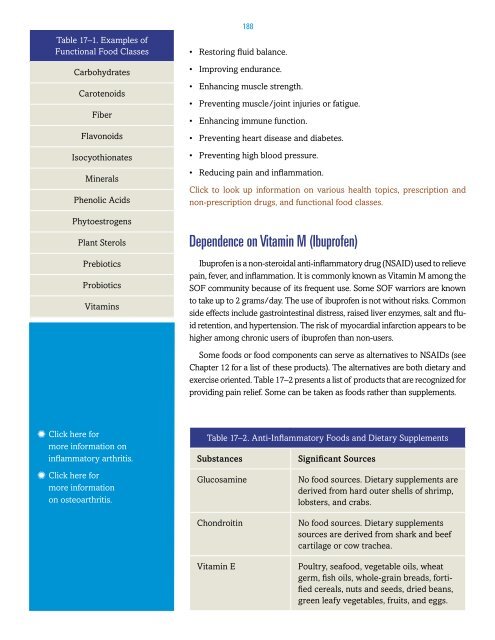special-operations-nutrition-guide
special-operations-nutrition-guide
special-operations-nutrition-guide
Create successful ePaper yourself
Turn your PDF publications into a flip-book with our unique Google optimized e-Paper software.
Table 17–1. Examples of<br />
Functional Food Classes<br />
Carbohydrates<br />
Carotenoids<br />
Fiber<br />
Flavonoids<br />
Isocyothionates<br />
Minerals<br />
Phenolic Acids<br />
Phytoestrogens<br />
Plant Sterols<br />
Prebiotics<br />
Probiotics<br />
Vitamins<br />
188<br />
• Restoring fluid balance.<br />
• Improving endurance.<br />
• Enhancing muscle strength.<br />
• Preventing muscle/joint injuries or fatigue.<br />
• Enhancing immune function.<br />
• Preventing heart disease and diabetes.<br />
• Preventing high blood pressure.<br />
• Reducing pain and inflammation.<br />
Click to look up information on various health topics, prescription and<br />
non-prescription drugs, and functional food classes.<br />
Dependence on Vitamin M (Ibuprofen)<br />
Ibuprofen is a non-steroidal anti-inflammatory drug (NSAID) used to relieve<br />
pain, fever, and inflammation. It is commonly known as Vitamin M among the<br />
SOF community because of its frequent use. Some SOF warriors are known<br />
to take up to 2 grams/day. The use of ibuprofen is not without risks. Common<br />
side effects include gastrointestinal distress, raised liver enzymes, salt and fluid<br />
retention, and hypertension. The risk of myocardial infarction appears to be<br />
higher among chronic users of ibuprofen than non-users.<br />
Some foods or food components can serve as alternatives to NSAIDs (see<br />
Chapter 12 for a list of these products). The alternatives are both dietary and<br />
exercise oriented. Table 17–2 presents a list of products that are recognized for<br />
providing pain relief. Some can be taken as foods rather than supplements.<br />
==Click here for<br />
more information on<br />
inflammatory arthritis.<br />
==Click here for<br />
more information<br />
on osteoarthritis.<br />
Table 17–2. Anti-Inflammatory Foods and Dietary Supplements<br />
Substances<br />
Glucosamine<br />
Significant Sources<br />
No food sources. Dietary supplements are<br />
derived from hard outer shells of shrimp,<br />
lobsters, and crabs.<br />
Chondroitin<br />
Vitamin E<br />
No food sources. Dietary supplements<br />
sources are derived from shark and beef<br />
cartilage or cow trachea.<br />
Poultry, seafood, vegetable oils, wheat<br />
germ, fish oils, whole-grain breads, fortified<br />
cereals, nuts and seeds, dried beans,<br />
green leafy vegetables, fruits, and eggs.


